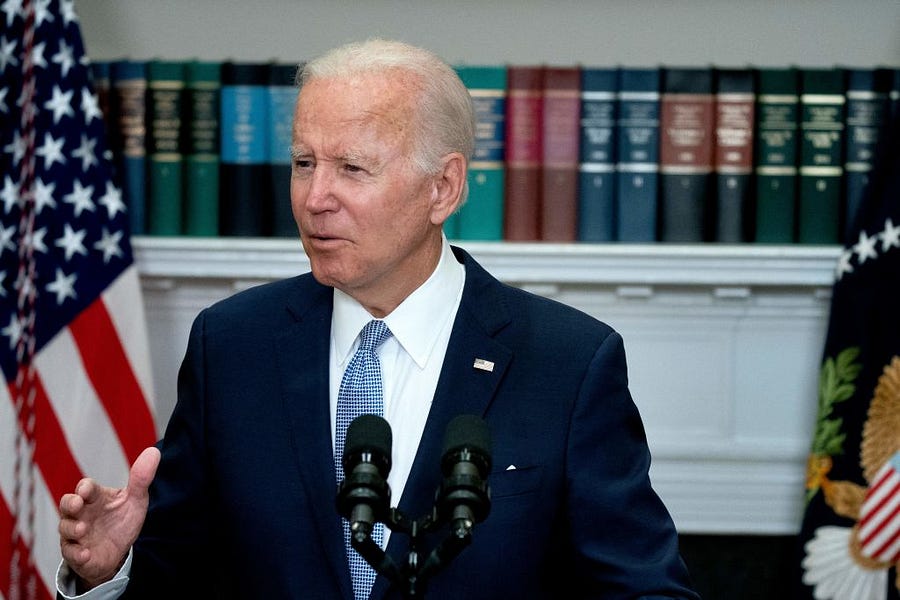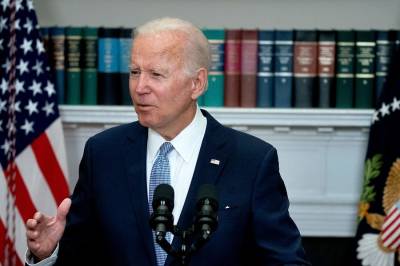Last Thursday marked the 50th Anniversary of Title IX of the Education Amendments of 1972, known simply as Title IX. Signed into law by President Richard Nixon, these 37 words ushered in a new era in higher education:
No person in the United States shall, on the basis of sex, be excluded from participation in, be denied the benefits of, or be subjected to discrimination under any education program or activity receiving Federal financial assistance.
President Biden’s Department of Education commemorated the 50th anniversary by publishing a 701-page notice of proposed rulemaking that aims to supplant Trump’s Title IX regulations. The proposal has several notable provisions, for example, further solidification of the Biden administration’s interpretation that Title IX bars discrimination on the basis of sex stereotypes, sex characteristics, sexual orientation, and gender identity, although it punts on the question of trans genderathletes in college sports for the time being.
Notwithstanding the importance of the aforementioned expansion, the issue pressing on the minds of victim advocacy groups, civil liberty watchdogs, school administrators, and parents of students across the nation is how the proposed regulations alter the sexual harassment adjudication process.
For most of Title IX’s existence, federal regulators focused on the elimination of barriers to women’s access to educational opportunities and programming. This included mandating equal athletic opportunities for men and women. If not for Title IX, many women would never have the opportunity to attend the school of their dreams, develop character through athletic competition, or receive the same quality of educational experience provided to their male counterparts. However, the focus of Title IX drastically shifted with the election of President Barack Obama.
In 2011, the Obama administration issued its (in)famous Dear Colleague Letter (“DCL”) to the education community, which replaced the 2001 federal guidance governing sexual harassment on campus. The letter called attention to the rise of sexual violence and demanded further action on the part of school administrators from K-12 to post-secondary institutions. In pursuit of this goal, the letter dictated several action points and mandated the adoption of procedures for the administrative adjudication of sexual harassment or sexual assault claims on campus. These adjudications carry a range of punishments, from educational solutions to expulsion. Although the letter was subregulatory guidance, meaning it did not have the force of law, the department explicitly threatened the loss of federal funding should it determine an institution fell short of the letter’s specific mandates. In order to expedite the administration’s need for action, the department declined to engage the formal notice and comment process that is required under the Administrative Procedures Act to adopt federal regulations.
During the remainder of the Obama era, dissatisfaction with the DCL framework grew exponentially, as did the number of administrative adjudications on campus. Civil liberty groups perceived the DCL as compelling institutional action while ignoring due process, perhaps even discouraging consideration of respondent rights. For instance, the DCL mandated that institutions take “interim” measures to protect the accuser (“complainant”) and explicitly placed the burden of these measures on the accused (“respondent”) prior to any finding of fault. In other words, respondents often found themselves suffering negative effects from the accusation before any consideration of the evidence against them. Advocacy groups consistently cried foul.
The DCL did not require a live hearing and many institutions adopted the “single investigator model,” where one individual both investigates the accusation, performs witness interviews, gathers evidence, and produces a determination of responsibility. This meant that no confrontation between the complainant and the respondent ever took place.
The election of Donald Trump provided relief to opponents of the DCL framework. Trump rescinded the DCL and, under the leadership of Secretary Betsy DeVos, the Department of Education launched a formal rulemaking process through public notice and comment. By August 2020, formal regulations were in place with many provisions directly addressing due process concerns.
Under the 2020 regulations, respondents were presumed to be “not responsible” for misconduct until they were formally found responsible by a preponderance of evidence. In support of this proposition, interim measures were required to be neutral in effect, meaning that the respondents were no longer the party primarily burdened. For example, under the DCL an institution could bar a respondent from a building in order to avoid confrontation between the parties. Under the Trump regulations, the institution may be required to bar both parties from a building to avoid conflict during the course of the investigation, or otherwise to work with both parties on an agreeable solution.
Additionally, the Trump regulations require a live hearing and an opportunity to cross-examine witnesses and parties through a designated adviser, who could be (but was not required tobe) an attorney. The hearing officer, who served as a combined judge and jury, was required to be separate from the investigator, thus eliminating the single investigator model embraced under the Obama era. This was a huge win for due process hawks.
The right of cross examination was initially bolstered by a requirement that parties or witnesses providing evidence must be open to cross-examination; otherwise, the institution was prohibited from relying on the witness’s statements. A U.S. District Court rejected this provision and as a result, the Biden administration, which never approved its merits, declined to enforce it further.
Of course, the Trump regulations have their own share of critics, particularly among those advocating for complainants, who perceive the live hearing and indirect cross-examination requirements as “re-victimizing” the complainants. These critics include President Biden. Upon his election in 2020, President Biden immediately signaled his intent to adopt new regulations. After less than two years under the Trump rules, the sand is once again shifting under the feet of students and administrators across the country.
Under the proposed regulations, the live hearing requirement is dead and the single investigator model resurrected from its 2020 grave.
The definition of a sex-based hostile environment reverts to the Obama-era definition of “unwelcome sex-based conduct that is sufficiently severe or pervasive” as to “deny or limit a person’s ability to participate in or benefit from the [school’s] education program or activity.” This expands the scope of punishable conduct considerably as the current definition requires a heightened standard of “severe, pervasive, and objectively offensive.” In other words, conduct that has low severity, but is clearly pervasive, would not qualify as a hostile environment under the current definition, but it would qualify under the proposed regulations. This change, in addition to the expanded definition of sex discrimination will have the practical effect of many more adjudications on campus.
Another change buried in the proposed rule, but not highlighted in the Department’s summary of significant changes, concerns “emergency removal” of students under investigation for Title IX misconduct. Currently, institutions may remove a student from campus on a short-term, interim basis if they pose an immediate physical threat to the complainant or the campus community. The institution is required to conduct an individualized assessment of the present and imminent threat posed, while not making a determination as to the ultimate culpability of the student. For instance, a student that is currently physically threatening another student for filing a report could be removed temporarily until the threat subsides.
Under the proposed rules, the scope would expand to any threat, physical or non-physical. In essence, this expands the scope to include mental or emotional harm. In 2020, in response to public comments, the Trump rule makers explained their rationale for the limitation to physical harm:
We agree with commenters who asserted that adding the word “physical” before “health or safety” will help ensure that the emergency removal provision is not used inappropriately to prematurely punish respondents by relying on a person’s mental or emotional “health or safety” to justify an emergency removal, as the emotional and mental well-being of complainants may be addressed by recipients via supportive measures.
This expansion will not go unnoticed by civil liberty groups who may perceive it as a trap door for disproportionate interim measures.
Overall, the proposed regulations represent a major shift back to the Obama-era principles, but they do preserve some of the inroads made by due process advocates under the 2020 regulations. For example, the presumption of “not responsible” until proven responsible is preserved, along with the requirement that all interim measures be neutral in nature. In other words, the interim burden is not returning to the respondent, which is a significant win for respondent advocates. However, as noted above, there will be concern from respondents regarding the application of the emergency removal provision.
One of the more significant provisions for due process advocates concerns credibility analysis during the adjudication process. In place of the full prohibition on testimony not subject to cross-examination, the proposed regulations would prohibit institutions from “relying on a statement of a party that supports that party’s position if the party does not respond to questions related to their credibility.” A subject for public comment will certainly be what constitutes a question related to credibility. Almost anything you ask a party may incidentally affect a party’s credibility, especially in an investigation where the consistency of a party’s testimony is paramount.
Interestingly, the limitation only applies to statements supporting that party’s position. The department’s notice explains the intent is to prevent parties from clawing back previous “bad” statements by refusing to answer further questions regarding their credibility. Also preserved is the prohibition against drawing an inference of fault from the respondent’s decision not to answer questions, even those touching on credibility.
Although the proposed regulation cuts the requirement of a live hearing, they mostly accept the current live hearing format as a compliant option, including the use of cross-examination through advisers that may be attorneys. Whether to preserve the live hearing or return to the single investigator model will be up to each institution, meaning less consistency across the country.
The passage of Title IX was one of the most significant advances in education of the 20th century. Its positive effects continue to multiply exponentially through generations of expanded educational opportunities. However, today Title IX has become a political ping-pong ball batted around by successive administrations, which is unfortunate given the important nature of its mission. Students need clarity as to their rights and responsibilities. One can only hope that over the next 50 years, Washington can deliver long lasting regulations that mirror the simple clarity of those original 37 words.






Please note that we at The Dispatch hold ourselves, our work, and our commenters to a higher standard than other places on the internet. We welcome comments that foster genuine debate or discussion—including comments critical of us or our work—but responses that include ad hominem attacks on fellow Dispatch members or are intended to stoke fear and anger may be moderated.
With your membership, you only have the ability to comment on The Morning Dispatch articles. Consider upgrading to join the conversation everywhere.